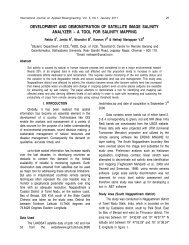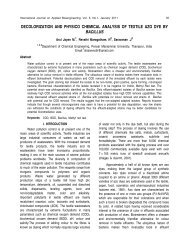Download Full Paper - Sathyabama University
Download Full Paper - Sathyabama University
Download Full Paper - Sathyabama University
You also want an ePaper? Increase the reach of your titles
YUMPU automatically turns print PDFs into web optimized ePapers that Google loves.
16 Vijayaraghavan et al : Biosorption of Acid red 88 onto Azolla pinnata: ....<br />
(2)<br />
where qt is the amount of dye sorbed at time t (mg/g)<br />
and k1 is the first order rate constant (1/min); k2 is the<br />
second order rate constant (g/mg min).<br />
C Biosorption isotherm models<br />
Four equilibrium isotherm models were used to fit<br />
the experimental data. These isotherms are the following:<br />
Langmuir: (4)<br />
Freundlich : (5)<br />
Toth : (6)<br />
Khan : (7)<br />
where q is the maximum dye uptake (mg/g), b is<br />
max<br />
the Langmuir equilibrium constant (L/mg), K is the<br />
F<br />
Freundlich constant (L/g), n is the Freundlich constant, b T<br />
is the Toth model constant and n the Toth model exponent;<br />
T<br />
b is the Khan model constant and a the Khan model<br />
K K<br />
exponent. All the model parameters were evaluated by<br />
®<br />
non-linear regression using MATLAB software.<br />
D Column experiments<br />
Continuous flow sorption experiments were<br />
conducted in a glass column (2 cm internal diameter and<br />
35 cm height). At the top of the column; an adjustable<br />
plunger was attached with a 0.5 mm stainless sieve. At the<br />
bottom of the column, a 0.5 mm stainless sieve was<br />
attached followed by glass wool. A 2 cm high layer of glass<br />
beads (1.5 mm in diameter) was placed at the column base<br />
in order to provide a uniform inlet flow of the solution into<br />
the column.<br />
(3)<br />
A known quantity of A. pinnata was packed in the<br />
column to yield the desired bed height of the sorbent. Dye<br />
solution of known concentration was pumped upward<br />
through the column at a desired flow rate by a peristaltic<br />
pump (Miclins). The concentration of dye at the vent of the<br />
column was collected at regular time intervals.<br />
The breakthrough time (t , the time at which dye<br />
b<br />
concentration in the effluent reached 1 mg/L) and bed<br />
exhaustion time (t , the time at which dye concentration in<br />
e<br />
the effluent reached the inlet condition) were used to<br />
evaluate the breakthrough curves. The slope of the<br />
breakthrough curve (dc/dt) was determined from t to t .<br />
b e<br />
The total quantity of dye mass biosorbed in the column<br />
(m ) is calculated from the area above the breakthrough<br />
ad<br />
curve (outlet dye concentration (C) vs. time (t)) multiplied<br />
by the flow rate. Dividing the dye mass (m ) by the sorbent<br />
ad<br />
mass (M) leads to the uptake capacity (q) of the alga [11].<br />
Effluent volume (V ) can be calculated as follows [12]:<br />
eff<br />
where F is the volumetric flow rate (mL/min).<br />
Total amount dye sent to column (m total)<br />
can be calculated<br />
as follows [12]:<br />
where C is the inlet dye concentration (mg/L).<br />
0<br />
Total dye removal percent with respect to flow volume<br />
can be calculated as follows [12]:<br />
All continuous experiments were conducted at room<br />
0<br />
temperature (30 C).<br />
E. Modeling of column data<br />
The column biosorption data obtained at different<br />
bed heights, flow rates and dye concentrations were fitted<br />
using the Thomas model. The linearized form of Thomas<br />
model can be expressed as follows (13) :<br />
(10)<br />
(8)<br />
(9)<br />
(11)









